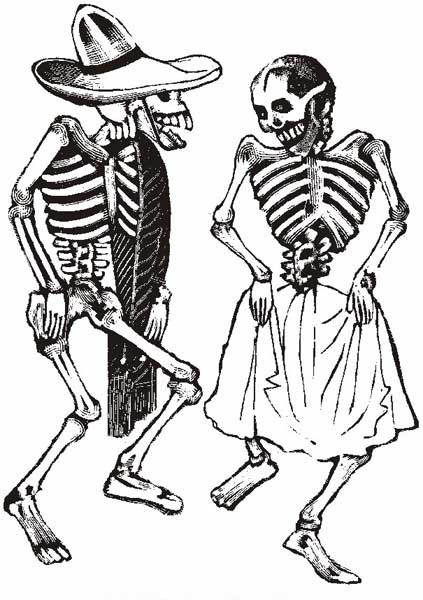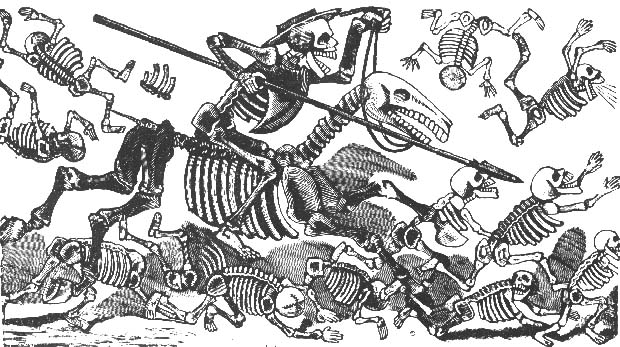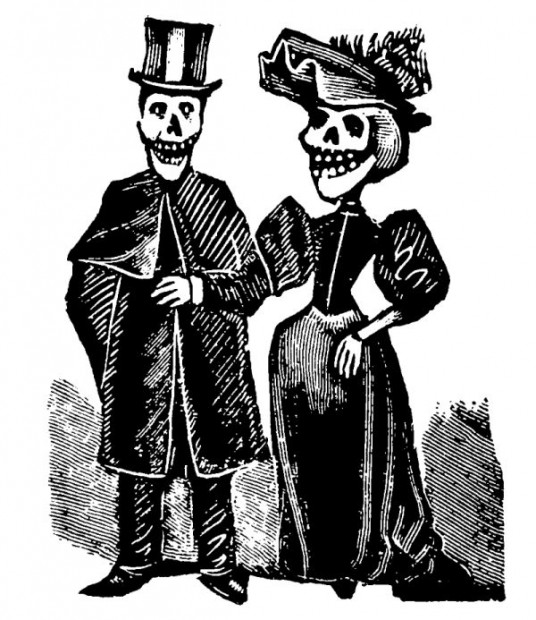By MoKa Hammeken
 In Mexico, the celebration of Day of the Dead is an entire multidisciplinary cultural fiesta with music, food, handcrafts, the creation of altars and tracing of drawings with flowers and seeds, and there are also letters.
In Mexico, the celebration of Day of the Dead is an entire multidisciplinary cultural fiesta with music, food, handcrafts, the creation of altars and tracing of drawings with flowers and seeds, and there are also letters.
Typical literature at Day of Dead is known as Calaveras, which are mischievous and humorous writings in the form of epitaphs, speaking of people as if they were deceased. The literary calavera is a traditional verse composition in Mexico, which tends to be written on the eve of Day of the Dead.
Every year, stories are told about different well-known individuals and even about tragedies that have burdened the country. These are written in an ironic tone, pointing to defects and criticizing the vices of a selected person, as if it were an aged and well-cared form of the now famous “roast”, with death as the common denominator. In these rhymes, people are deceased or are being visited by the bony figure of Death (I have read Calaveras about people who are so stubborn and so corrupt that not even Death wants them).
The Calaveras literarias are a sign of the creativity and irreverence of The Mexican, and its proximity with the inevitable which is Death and the world of the dead.
 The history of Calaveras is a bit fuzzy. During the XVIII century, the criollos and Mestizos would write anonymous satirical and funny texts on placards, at times called pantheons, as a manner to express feelings that on other occasions would be difficult, or in expressing their inconformity with Spanish authorities. These of course were not to the liking of the governing officials, so they were confiscated and destroyed.
The history of Calaveras is a bit fuzzy. During the XVIII century, the criollos and Mestizos would write anonymous satirical and funny texts on placards, at times called pantheons, as a manner to express feelings that on other occasions would be difficult, or in expressing their inconformity with Spanish authorities. These of course were not to the liking of the governing officials, so they were confiscated and destroyed.
Obviously, there must be hints toward these in one or another Mexican novel, as is suggested by Blanca López de Mariscal, Hispanic literary researcher, who states “possibly these were the most ancient Calaveras in printed form conserved in Mexico,” when speaking of Periquillo Sarniento (1816) by José María de Lizardi. According to the researcher, these included poetic compositions in form of an epitaph. It is worth noting she also wrote the introduction and notes to a critique edition of the book La Portentosa Vida de la Muerte by Joaquin Bolaños, originally printed in 1792, remarking within the presentation that Bolaños himself warns his reader “It comes in the form of a story because I want to enjoy myself; it has a bit of mysticism because I also intend to deceive you, separate the precious from the vile, take advantage of the serious and laugh at the burlesque…” using the cartoonish resource within Mexican literature when referring to Death.
Yes, Mexico has a history of ingenious musical responses, humorous and joking literature, and critique of oppressors.
Even so, the first formally registered Calaveras in print were published by the newspaper El Socialista in Guadalajara, Jalisco in 1849. A short time later, this type of verse was accompanied with drawings and etchings of the Calavera Garbancera, a personification of Death (also in an ironic and joking tone), created by José Guadalupe Posada, that was rebaptized years later as the Catrina by the muralist Diego Rivera.
Now, the tradition continues and calavera contests are organized each year. Calaveras can be read in the newspaper and go along with the festive and joking environment of this healthy folklore, which apparently clashes with the dismal idea of death.
Calaveras en letritas
Por MoKa Hammeken
En México la celebración del Día de Muertos es toda una fiesta cultural multidisciplinaria donde hay música, comida, artesanías, se crean altares, se trazan dibujos con flores y semillas, y también hay letras.
 La literatura típica del día de muertos se les llama Calavera y son composiciones picarescas y humorísticas escritas a modo de epitafios, retratando a las personas como si estuvieran muertas. La calavera literaria es una composición en verso tradicional en México y suelen escribirse en vísperas del Día de los muertos.
La literatura típica del día de muertos se les llama Calavera y son composiciones picarescas y humorísticas escritas a modo de epitafios, retratando a las personas como si estuvieran muertas. La calavera literaria es una composición en verso tradicional en México y suelen escribirse en vísperas del Día de los muertos.
Cada año, se versa sobre diferentes personajes conocidos o incluso sobre las tragedias que agobiaron al país, Estas se escriben un tono irónico exhibiendo los defectos y criticando los vicios del personaje elegido, como una forma antigua versada y cuidada del ahora famoso “Roast”, siendo un común denominador la muerte; en estas rimas, las personas están muertas o están siendo visitadas por la huesuda (he leído calaveras sobre gente tan necia y tan corrupta que ni la muerte los quiere).
Estas son muestra de la creatividad e irreverencia del mexicano y de su acercamiento con lo inevitable que es la muerte y el mundo de los muertos.
La historia de las calaveras es un tanto difusa. En el siglo XVIII los criollos y mestizos escribían pasquines, textos satíricos y burlones de forma anónima llamados a veces panteones, como medio para expresar sentimientos que en otras ocasiones sería difícil o su inconformidad con las autoridades españolas. Estas por supuesto no eran tan del agrado de los gobernantes, por lo que muchas se confiscaban y se destruían.
Obviamente debe haber indicios de esto en una que otra novela mexicana, como lo sugiere la investigadora de letras novohispas Blanca López de Mariscal “posiblemente se trate de las más antiguas calaveras insertadas en una obra impresa que se conservan en México”, hablando del Periquillo Sarniento (1816) de José María de Lizardi, y es que según la investigadora se incluyen composiciones poéticas a forma de epitafio. Cabe señalar que también escribió la introducción y las notas de la edición crítica del libro La Portentosa Vida de la Muerte de Joaquin Bolaños (fray) impresa en el año de 1792, haciendo notar en la presentación que el mismo Bolaños advierte a su destinatario “Va en forma de historia por que quiero divertirte; lleva su poquita de mística por que también pretendo desengañarte, separa lo precioso de lo vil, aprovéchate de lo serio y riéte de lo burlesco…” llevando así el recurso caricaturezco en la literatura mexicana a cerca de la muerte.
Si de respuestas musicales ingeniosas, literatura jocosa y burlona y de criticas a opresores, México tiene historia.
Aún así las primeras calaveras impresas de las que se tienen registro formalmente fueron publicadas por el periódico El Socialista en Guadalajara Jalisco en 1849. Poco tiempo más tarde este tipo de versos iban acompañados de dibujos y grabados de la Calavera Garbancera, una personificación de la muerte (también en tono irónico y burlón) creada por José Guadalupe Posada, rebautizada años después como Catrina por el muralista Diego Rivera.
Ahora, la tradición sigue y se organizan concursos de calaveras. Se leen calaveras en los periódicos y siguen con este ambiente festivo y chusco de este sano folclor, que al parecer choca con la idea de muerte lúgubre que se tiene.
